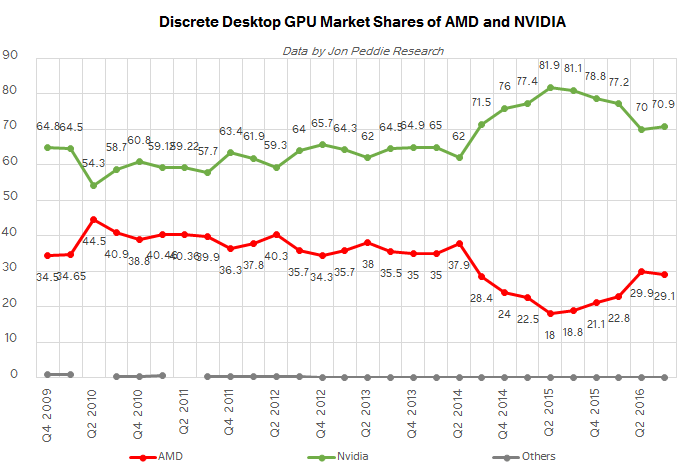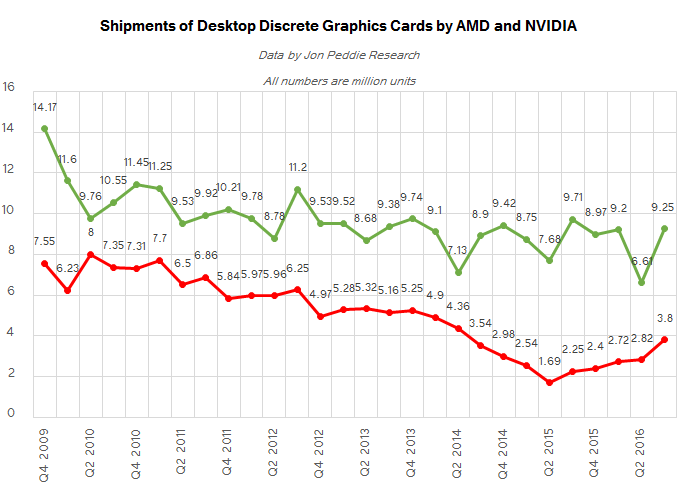Discrete Desktop GPU Market Trends Q3 2016: GPU Shipments Hit Two-Year High
by Anton Shilov on November 28, 2016 9:00 AM ESTMarket Share: AMD Is Increasing Units, Not Share
Last year AMD addressed the high-end of the market with unique products like the Radeon R9 Fury series with HBM memory, as well as the Radeon R9 Nano aimed at small form factor systems. This year the company decided to focus on mainstream video cards with its Radeon RX series (previously known as Polaris). So far, this tactic has been paying off: over the past 12 months, AMD regained over 10% of the market and increased quarterly shipments of desktop discrete GPUs by over 1.5 million units.
AMD shipped approximately 3.8 million standalone graphics chips for desktop computers in the third quarter of 2016, which is a two-year high, according to Jon Peddie Research. The company’s desktop discrete GPU sales were up nearly one million units from the previous quarter (an increase of 34%) and grew by over 1.5 million units from the same period last year (an increase of 68.8%). Meanwhile, AMD’s market share declined 0.8% from the previous quarter (Q2 2016) due to strong NVIDIA performance but surged 10% from Q3 2015.
NVIDIA also managed to increase its discrete desktop GPU shipments in the third quarter significantly. The company sold 9.25 million GPUs, up from 6.61 million in Q2 2016 (an increase of about 40%), and up from 8.97 million in Q3 2015 (an increase of 3.1%). NVIDIA typically clears out its inventory in the second quarter, hence, its sequential growth of chip sales in the third quarter is not particularly surprising. Meanwhile, the company has managed to bring its sales back to recent historical levels, which is not bad on a market that has been on a decline for years.












53 Comments
View All Comments
Shadowmaster625 - Monday, November 28, 2016 - link
It's actually rather sad that discrete GPU sales are only up 10% vs a year ago when they had been sandbagging on 2011 process tech for 4 years. I would have expected 14nm/16nm to provide a larger boost to sales.lefty2 - Monday, November 28, 2016 - link
This is because no one is buying desktops anymore. All the top tech companies give there employees laptops, not desktops: http://www.techworm.net/2016/11/computerlaptop-big...TheinsanegamerN - Monday, November 28, 2016 - link
And the majority of those desktops were using integrated solutions, not dedicated ones. Business moving to laptops hasnt had that big of an impact.Sarah Terra - Tuesday, December 13, 2016 - link
The slower sales are because of this reason: Nvidia has been milking process and architures for abnormal periods in order to maximize profts. As such a 2-3 generation old GPU is usually still "good enough" for most poeple, much like how users clung to sandy bridge. Back in the day, if you had a 3 year old GPU you were left in the dust, upgrades were far more frequent and necessary to keep pace. Nvidia is eseentially monopolizing themselves to a smaller market share, more competition will boost sales.Atique786 - Friday, October 1, 2021 - link
This is a very informative and interesting article. I have enjoyed reading your post and have come to the conclusion that you are a professional writer.https://realrelaxmassagechairreview.com/
<a href="https://realrelaxmassagechairreview.com/">... Relax Massage Chairs</a>
<a href="https://realrelaxmassagechairreview.com/real-relax... Relax Massage Chair Review</a>
<a href="https://realrelaxmassagechairreview.com/real-relax... Relax 2020 Massage Chair</a>
OldManMcNasty - Thursday, December 8, 2016 - link
Our engineers get whatever they want, I have a SurFace Pro 4 but I also have a virtual workstation with a Nvidia vGPU. If you're not an engineer, you're given a virtual desktop or you can select an iPad.Amna - Monday, February 14, 2022 - link
I really like the blog.I have shared your site with many friends and family. It is always a pleasure to read.<a href="https://realrelaxmassagechairreview.com/real-relax... Real Relax Massage Chair</a>
nathanddrews - Monday, November 28, 2016 - link
Larger than 10%? Why would you expect that?DanNeely - Wednesday, November 30, 2016 - link
Steadily bigger died and more efficient 28nm designs kept the performance gains coming, despite the process lag there wasn't a correspondingly huge buildup of demand.BurntMyBacon - Thursday, December 1, 2016 - link
@Shadowmaster625: "It's actually rather sad that discrete GPU sales are only up 10% vs a year ago when they had been sandbagging on 2011 process tech for 4 years."You are making a perhaps faulty assumption that most people buying GPUs know or care what processes nodes do for the video card they are buying. In my estimation, more people are concerned with how much it costs and if it does what they want it to do. I don't suspect many of them track how new cards compare to the last gen products, much less the several generations back that they would need to know to be aware of the process node stall.